I recently had a chance to take Close Quarter Battle: The Study from Roger Phillips and “Ninpo Student.”
I’d taken a CQB class from Roger several years ago up in Las Vegas. He does a great job presenting the material and making the lessons very understandable and applicable for the armed citizen.
Ninpo Student has extensive military experience doing CQB; he’s been in a lot of gunfights over in the sandbox. This experience gives him a wealth of knowledge when it comes to CQB.
I actually first met Ninpo as a fellow student in that CQB class with Roger several years ago. It really says something about him that, despite his vast experience, he was attending a course from a civilian instructor in his area of expertise. That sort of thing is a big part of why I have such great respect for him.
Roger set this course up with both a 3-day and 2-day option. The three-day version had a live fire day on Friday at a local range, with non-shooting CQB instruction on Saturday and Sunday at a local manufacturing facility that was kind enough to host the class. The two-day version just included the non-shooting days. While I would have loved to do the shooting portion as well, I also wanted to minimize the use of my vacation days, so I went for the two-day version.
Gear
As a non-shooting class, this wasn’t nearly as gear-heavy as a lot of courses. I brought a rubber gun (one of the orange Blackhawk Glock trainers) and an extra holster for it.
Since Ninpo would be teaching some long gun stuff, I also wanted to bring a rifle. I actually went through quite a debate about what to bring. I don’t have an AR blue gun so it would have to be a real rifle. However, I was reluctant to consign an expensive rifle, optic, suppressor, and other accessories to the tender mercies of the TSA and airline baggage handlers, especially when I wasn’t even going to do any live fire with it.
In the end, I ended up slapping an Aimpoint T-1 on my simplest (and cheapest) SBR, but foregoing a suppressor or any other accessories. I did get an inexpensive Burris picatinny rail riser so that the T-1 would better match the height of the Leupold in a tall mount on my main fighting rifle.
Given that this rifle was basically going to be used as a glorified blue gun, I almost didn’t bother zeroing the optic or bringing any ammo for it. However, I found myself incapable of bringing a self-defense tool on a trip without setting it up for proper use. So I did a quick zero at the range last week and brought along 90 rounds of ammo for it.
I had intended to bring a Streamlight ProTac Rail Mount 2 that I’ve got set up on a QD mount and move between rifles that don’t have a permanent light setup. Unfortunately, that didn’t make it on to my packing list. Thankfully, Cabela’s is just a few miles from the hotel where I’m staying, so I was able to pick up an identical light and a Magpul offset mount for it.
Friday
I flew out to Arizona on Friday, arriving in the early afternoon. I lived in Phoenix for over 20 years, so the familiar furnace-blast of heat when I walked out the door at Sky Harbor Airport brought back memories.
I made a WalMart run and spent a bit of time looking around at Cabela’s before checking in to my hotel. As I was unloading my stuff, I ran into Roger in the hall and we chatted for a bit. He’d finished up the live-fire day and was just getting back from the range.
That evening I had a chance to have dinner with my cousin and his wife (they live in the Phoenix area). We had some excellent sushi and had a good time catching up after not having seen each other for a while.
Saturday
I ran into Roger and his wife again in the hotel’s breakfast room, and we had a chance to talk a bit as we ate.
The venue for the class was just a few miles down the road. It’s a manufacturing facility divided between some office space and a factory floor-type area. The office space had individual offices around the outer walls with cubicles in the middle. They were doing a production run on Saturday, so the manufacturing area was off limits to us.
Everyone arrived in pretty short order at the 8 o’clock start time. Many of the students in the class were people I’d trained with before in various classes out in Arizona and Nevada. It was great to train with them again.
We got started by signing the usual waivers. Roger and Ninpo talked through the procedures we would be using to ensure there would be no live weapons in the training environment. Most of the students had handgun replicas (either airsoft or rubber guns like the one I’d brought). For those that didn’t, we flagged the chambers using some vinyl tape. To disable long guns we pulled the bolt carrier group, leaving the gun in an unfireable condition.
All of our carry guns were unloaded and stored in a separate room, along with any knives or other weapons. At the start of the day and after people came back from lunch, Roger and Ninpo searched everyone and checked their weapons to make sure there were no live guns. Both of them emphasized the long history of incidents where people had been shot or unintentionally shot others due carelessly violating the separation between the training environment and the carry environment. This happens when either someone brings an operational weapon into what’s supposed to be a dry training environment or when they try to do one more training iteration after gearing up for carry.
Roger and Ninpo introduced themselves and talked a bit about their backgrounds and experience. Ninpo emphasized that he wanted us to “keep this stuff off the internet” so I will be circumspect. He served in a role where he trained extensively in CQB work and has multiple combat deployments under his belt where he spent most of his time hitting targets and clearing buildings. This wealth of real-world experience makes him an incredibly good instructor for a class like this.
He’s now in civilian life, and he mentioned that his current boss was giving him some static about outside work (like this class), which is why I’m using his online nome de plume rather than his name in this write-up.
One of the things that Ninpo and Roger emphasized was the difference between theory and practice. Ninpo talked about how much the CQB tactics of the military’s high-level units have changed since 9-11 because some of the pre-war theories did not match up with the conditions (and missions) that they encountered on the battlefield in Afghanistan and Iraq. These are hard-won lessons that a lot of guys paid for with their lives.
Roger talked about the four potential missions that a civilian might be trying to accomplish in CQB: barricade in position, search and clear, hunting and engaging, and evade and escape.
Barricade in position is the simplest and easiest to execute. The classic scenario for this is if you hear someone breaking into your house and there isn’t anyone elsewhere in the house that you need to go and protect. You can stay where you are, call 911, and be ready to defend yourself if the intruder comes to you. “Barricade in position” is the politically correct term for this, but the reality is that you’re setting up an ambush. While this is a great situation to be in if you can manage it, it’s not always possible.
For instance, what if you’re not sure there’s been a break-in? You may hear a noise, but it’s not clear that it’s an intruder. If you call 911 every time you hear something in the middle of the night, pretty soon you’re going to be the boy who called wolf. So, sometimes you have to go check things out. There’s no time pressure, you can take as long as you need to search and clear the house, but you need to verify whether or not there’s an intruder (for your own peace of mind if nothing else).
Another situation where barricading in place isn’t possible is if you hear an intruder in your home when there are other people you need to protect elsewhere in the house. If your kids or other loved ones are in danger, you’re not going to just sit there in a defensive position. Hunting and engaging relies on many of the same techniques as search and clear, but at a much faster pace. This is a tradeoff: it’s much more dangerous, but it gets you to the person you need to protect much faster.
Of course, not every CQB situation is a “bump in the night” scenario. You may be caught in an active shooter or similar situation where your objective is to get out. Evade and escape relies on the same fundamentals as search and clear and hunting and engaging, but the application is a bit different.
Roger talked a bit about the OODA loop (Observe, Orient, Decide, Act) and the reactionary curve. A lot of the point shooting material that Roger is known for teaching are skills for situations where an opponent has the drop on you, and you’re behind the reactionary curve. This is a very sub-optimal situation and responding to it effectively requires some compromises. CQB is a much more proactive environment (though there may be moments when you’re in a reactive situation). A big emphasis in this class was in making sure we got away from those reactive skills and used a proactive skillset optimized for accurate, offensive shooting.
The most likely place an armed citizen will have to utilize these skills is in their own home. One advantage here is that we can “prepare the battlefield” to make things easier for us if we have to clear our own house. We talked some about stuff like -putting up mirrors to make it easier to clear difficult locations, using night lights to backlight someone approaching your bedroom, and keeping certain doors closed to make clearing problems easier.
Ninpo emphasized the need to ask yourself, “Is there anything in this room worth dying for?” If your kid is in that room screaming bloody murder, then yes, that’s worth risking your life for. But if that’s not the case, once you’ve verified that there is a threat in that room, deciding not to push through that door and take on that adversary is a perfectly valid decision. In the civilian context, that might mean pulling back to a safer location and dialing 911. On the military side, if they encountered heavy opposition and didn’t have a compelling reason to fight it out (hostages to rescue, etc.), they’d often pull back and bomb the building.
Ninpo also talked a bit about speed (something that would come up repeatedly throughout the class). There’s a tendency to do everything at “hostage rescue” speed. But if you don’t have hostages to rush and save, there’s no reason to go that fast. He said a lot of guys died early on in Iraq and Afghanistan because of this. As he’s fond of putting it, “I can’t fight faster than I can process the environment.” If you move too quickly, you’re in danger of “outrunning your headlights.”
As an aside, Ninpo noted that while we tend to conflate CQB with “fighting in a structure,” technically the military regards any fight at ranges of less than 50 meters as CQB. A lot of outdoor fights (especially in terrain that restricts visibility like jungle or tight urban areas outside of buildings) take place at under 50 meters. On the flip side, fights inside structures can sometimes involve considerably greater distances. He once used a laser rangefinder to measure one of the main aisles at WalMart at 227 meters (he did this to make a point to a SWAT team he was helping train about the need for a zero that could accommodate longer shots). His preferred term for what we’re doing in this class is Fighting In Someones’ House or FISHing.
While some folks had a chance to do live fire on Friday others in the class (including me) had not, so Roger and Ninpo did some review. Roger talked through the locked wrist handgun grip. It’s been discussed quite a bit on Paragon Pride, so I won’t repeat it here. However, there was one element that was new to me (I gather this was something Ninpo introduced Roger to on Friday): torquing the hands together like you’re trying to pinch the top of the frame. Basically, you apply counterclockwise pressure with your right hand and clockwise pressure with your left hand, trapping the gun between them. This has the effect of rotating your elbows out. I’ve heard the debate between “elbows out” and “elbows down” when shooting isosceles before, but the way Ninpo described it, the elbow position is a side effect of applying this pressure to the top of the frame.
Ninpo demonstrated his preferred carbine stance: squared up to the target, stock mounted under the dominant eye, aggressive forward lean with the strong side leg back to direct recoil energy into the ground. As with the handgun grip, there’s an excellent thread on Paragon Pride describing this in a lot more detail. One thing Ninpo emphasized for this class is that your foot position may not always be optimal. You may be moving, or you may stop to engage with the “wrong” leg back. That’s okay. Better to start shooting when you can rather than waiting to assume the “perfect” stance. But once you’ve started shooting, if it looks like this is going to be a more prolonged engagement, you might take a step forward (or back, depending on the situation) to get in that optimal stance.
Ninpo talked a little about ready positions, both the high ready and the low ready. One thing he noted is that people tend to tense up when searching for BGs. They crouch down, grip the gun very hard, try to maintain a hardcore shooting stance the entire time. If you’re doing a slow, methodical search and clear this way, you’ll wear yourself out clearing the first room. Keep the gun up, but hold it more loosely and stand upright rather than crouching down. When the time comes to shoot, then you drive the gun into your optimal shooting position.
After a break, we started talking about corners. The corner is the building block of CQB. Almost every problem can be described as a combination of one or more corners and the same basics principles apply to all of them. Roger and Ninpo broke out the whiteboard markers and diagrammed out how you do an angular search of a corner.
Ninpo emphasized that when talking a corner, your movement should be continuous. When you’re doing a deliberate search, it may be very veeery slow, but you shouldn’t come to a complete stop. Part of this is psychological. If you stop and lose momentum during CQB, it can be difficult to get yourself started again.
He also stressed that you should expect a potential target in every danger area. You should never just be going through the motions and looking (and pointing your gun) at a danger area not expecting a threat to be there.
The flip side of this is proper target identification, and it’s something that Ninpo really emphasized. Most of the folks in this class lived in jurisdictions that are pretty permissive when it comes to home defense, but just because you can legally shoot someone doesn’t mean you should.
In the home defense context, Ninpo divided up intruders into three categories: daytime burglars plying their trade, inebriated or mentally altered neighbors blundering into the wrong house, and those who invade a home not caring or even wanting to do so when someone is at home. Intruders in the first two categories usually don’t need to be shot, while those in the third category need to be shot as soon as possible. The hard part is distinguishing between them.

We moved out into the office area, and Ninpo and Roger demonstrated how to take a corner using an L-shaped hallway as an example. The basics were familiar: a slow, deliberate angular search, exposing as little as possible, staying as far from the corner as terrain allows, to see as much as you can before you get to the decision point where you have to commit to taking the corner. Ninpo had a couple of refinements that were new to me: one was turning in the toe of your lead foot, to make it less likely that a stray toe will be the first thing to give you away.
If you see something, some sign of an adversary, you have to make a decision whether you’re going to proceed around this corner or pull back. This gets back to your mission. If you’re searching your home for the source of a suspicious noise and everyone you need to protect is someplace safe, once you verify that there is, in fact, an intruder, pulling back to a good defensive position and calling the police to come and deal with the intruder is a perfectly valid choice. On the flip side, if this intruder is between you and your loved ones, the need to push forward and deal with him is much greater. You have to ask yourself, “Is there anything in this room worth dying for?” Sometimes the answer is yes.
Ninpo really made a point of accelerating through the area of greatest danger (as you actually round the corner) then slowing back down once you’ve bought and paid for that danger space. This theme of shifting gears, slow-fast-slow, was one that would come up again and again throughout the class. Most folks didn’t have any trouble with the “slow-fast” transition. The transition from fast back to slow, on the other hand, did not always go so smoothly. Once you start going fast and you want to keep going fast. Roger or Ninpo calling for the student to, “Stand up. Relax.”, was a fixture after almost every drill.
Ninpo noted that slowing down after clearing the danger zone applies even if you encounter an adversary around that corner. In fact, it may be even more important. You don’t want to run right up into the guy. Slow down, even stop if necessary until you’ve dealt with the adversary. This is an area where this sort of movement is different from busting off the X. We’re moving to clear a dangerous area and get to where we need to be to fight most effectively. We may be shooting as we do this, but the goal is to get out of the danger area or get to our desired fighting position.
He also pointed out how, even in training, this sort of thing is very stressful (I can only imagine how stressful it is in combat). Stress is uncomfortable, and our natural reaction to uncomfortable situations is to get them over as fast as possible. That’s a big part of what keeps pushing us to go faster and faster.
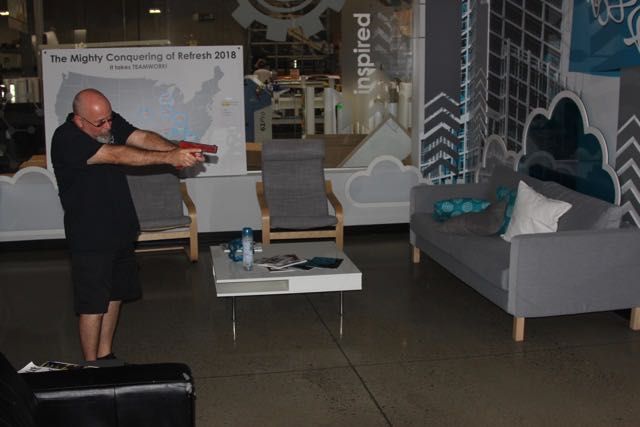
Roger and Ninpo talked about how to shoot during controlled movement. In contrast to dynamic movement where you adapt your shooting to your movement, this is all about adapting your movement to provide a good shooting platform. Lower your center of gravity, take smaller steps, and roll the feet from the heel to the toe (the classic “Groucho” walk).
Ninpo mentioned that in combat he did very little shooting from the support side. They did quite a bit of it during training (around 40% of their practice was from the support side), but it rarely came up in the type of fighting that they were doing. While he would switch sides if he was posting up on a “wrong handed” piece of cover or concealment, he would not swap shoulders when moving or pieing a corner.

We split into two groups, with Roger taking half the students and Ninpo taking the other half. Everyone had a chance to work both right-handed and left-handed corners.
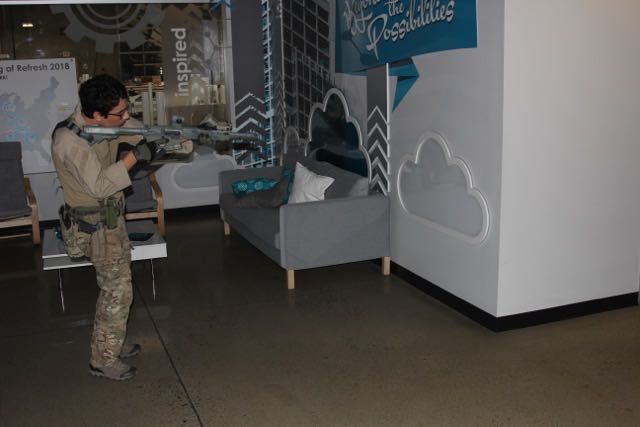
It took a while for some students to get the hang of exposing as little of themselves as possible while they conducted their angular search. It’s very easy to let your elbow, shoulder, foot, or even your toe become visible to the adversary before your eye gets far enough around the corner to see him.
Next up we started working T-intersections. A T-intersection is just a pair of corners, and the same principles of working a corner apply. The complicating factor is that you need to work two corners simultaneously. Since we don’t have eyes in the back of our heads, that means picking one side of the T and working it while not exposing ourselves to the other side, then switching to the other side of the hall and taking a bite off of that side of the T. You alternate sides until you’ve seen everything you can see without exposing yourself to the other side of the T.
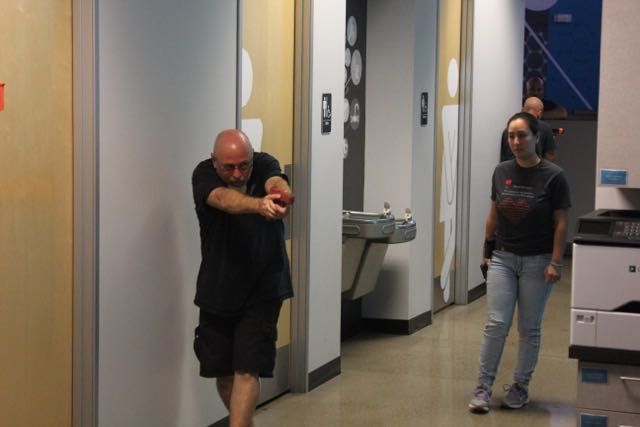
When you get to that point, you have to pick a side and commit to it. If you haven’t seen an opponent yet, this is something of a guess. However, we can make it an educated guess. Based on the architecture of the building, which direction is the larger space? Based on the scenario, where would your adversary be coming from or where would they be hiding? If it’s still a coin flip, think about which direction you intend to continue your search in and make your initial movement in the opposite direction (this minimizes the number of times you’ll have to recross the stem of the T).
As with the L shaped hallway, you want to accelerate through the corner then slow down so you can see and engage any adversaries. If there’s no one there, immediately, turn 180 degrees and check for threats in the other direction as you cross the hallway that forms the stem of the T.
When doing that 180 turn, Ninpo demonstrated that it’s easier and more controllable to drop the gun down to Sul as you turn and bring it up when you’re facing in the new direction. Similarly, Roger demonstrated that with a handgun it’s most efficient to bring the gun into a compressed ready, turn, and drive the gun out (similar to count 4 of a 4-count drawstroke) once you’re facing the new direction.
Again, we broke into two groups and worked the T-intersections. The most common issues related to taking too big of a “bite” and exposing themselves to an area on the other side of the T that they hadn’t cleared. The thing you expose this way is most often the muzzle of your gun so it can be mitigated by retracting the gun in to some sort of retention position, or just by taking smaller bites.
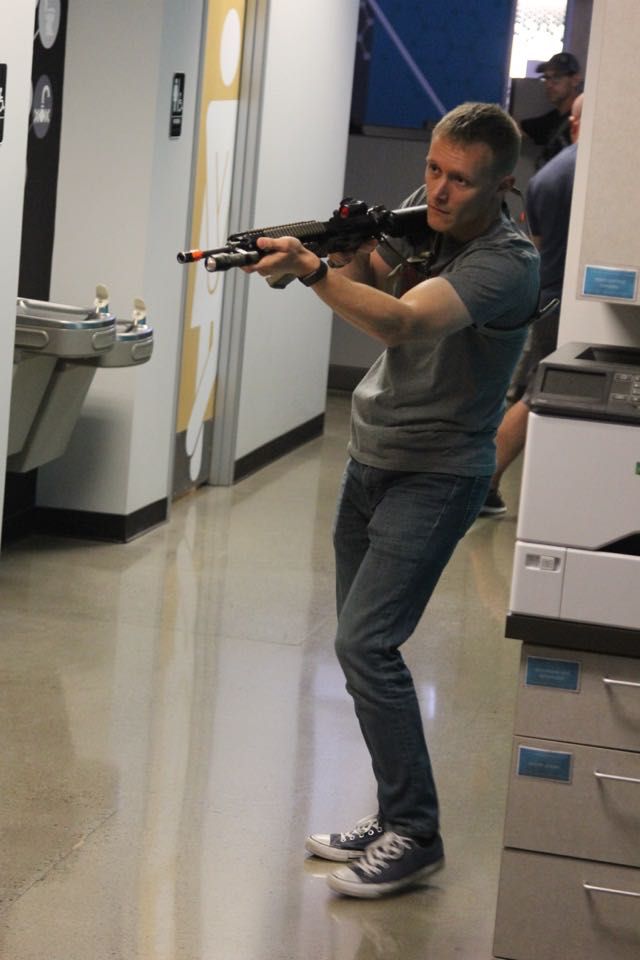
Ninpo mentioned that operating as an individual, he would prefer to fight out of rooms, using hallways only to move between them. This is because he can only look one direction at a time and once he’s cleared a room, he can direct that focus toward the doorway rather than dividing it among multiple areas of potential threat. As part of a team, he’d prefer to fight from the hallways, only entering rooms as necessary to clear them, because a team can cover multiple directions and lock down a big chunk of a building by covering the hallways.
We took a break for a (late) lunch. After everyone ate, we moved on to dealing with open doors. Again, a door is just a pair of corners, like a T-intersection. However, they’re a special case because the way you work a door is influenced by the geography of the room beyond, and it’s going to be a narrower opening for you to work (there’s also the fact that the door may be closed, but we weren’t even getting into closed doors yet).
Coming to an open door, you want to see as much as possible from the outside, so you do an angular search, the same way you would any corner. Some previous classes that I’ve taken emphasized doing a very complete angular search, up to a full 180 if the terrain allowed it, so you can see as much as possible of the room beyond. Ninpo’s take on this was that if you’re working a door off of a hallway, usually there’s a part of that hallway that you haven’t searched, from which an adversary may emerge. When doing his angular search, he doesn’t want to swing around far enough that he has his back to this unknown threat. The point at which he decides he’s seen all he can and needs to either make entry or back off may be dictated by when he can no longer keep the unsearched portion of the hallway in his peripheral vision. So the way you handle a door is dictated both by the geography of the interior of the room and the geography outside that room.
Once you’ve seen all you can see, you have to decide whether or not you’re going to enter. Again, Ninpo emphasized, “Is there anything in this room worthy dying for?”
As with any corner, you want to accelerate quickly through the corner itself, then slow down. A door is a bit different because the aperture is generally narrower (we were working in a commercial building with 36” doors, but many residential interior doors are going to be narrower: 30” or even 24”).
Once you’re through the door you want to move towards the area of greatest unknown danger; usually a corner of the room that would weren’t able to see during your angular search. The rooms that we were working with were all corner fed rooms (meaning the door was next to a corner of the room rather than being in the middle of the wall). In a corner fed room there’s usually only one corner that you couldn’t get a look at during your angular search.
Unfortunately, the width of the door may mean you can’t take the angle going through it that you’d really like without the risk of bouncing off the doorframe and throwing off your entry. If you need to radically change your angle of movement as you go through the door, Ninpo’s preferred solution is the doorjamb takeoff. You can plant your foot up against the doorjam and drive off that leg to change your direction of travel.
Sometimes you don’t need to change the angle your angle of travel that much, you just need to take a sharper angle than the door allows. Ninpo showed a nice technique for sidestepping through a door like this that gets you through a narrow opening quickly, without losing your momentum.
Ninpo noted that when clearing a room against a prepared defender, our only real advantage is that we’re the ones initiating the action. We get to choose when we go. While it may not come as a complete surprise to our opponent, they are at least reacting to us rather than the other way around. Since that split second of reaction time is our biggest advantage, it’s particularly important not to allow your muzzle to precede you into the room. If you’re using a pistol, retract it into a compressed ready or even come all the way back to Sul. With a rifle Ninpo showed the short stock technique: you rotate the rifle 90 degrees to lay it flat across your chest (much like going to Sul) while you retract the rifle, pulling the stock up above your shoulder. This allows you to get the rifle in very close to your body, yet mount it very quickly (and even start point shooting before you have it fully mounted if necessary). He mentioned that this is one of the ready positions he puts a lot of practice into mounting and shooting from when he’s at the range.

We split up into two groups and worked some of these skills. In Roger’s group, one of the things we noticed was that when he was demonstrating, several times he switched hands or went one-handed despite his intent to stick with a strong side, two-handed grip in this class. It just goes to show how ingrained some of these skills can be.
Doing doors naturally segued into a bit of work clearing the room beyond. Ninpo talked a bit about clearing underneath or behind stuff like the office furniture we had in these rooms. He talked about what the priority would be and where he would look for a hidden opponent first.
As we were doing this a fellow from Tucson, who has taken many of Roger’s classes, dropped by. He couldn’t make the entire class, but he drove all the way up to Phoenix just to hang out with everyone for a little bit.
Moving on to closed doors, Ninpo talked about different approaches depending on your mission. If you’re doing a methodical search and clear and have plenty of time, the best approach is often to throw the door open (calibrating the amount of force you use so that it will stay open, which is an art in and of itself) and pull back rapidly. If the open door reveals a part of the room with an adversary in it, then you have to deal with that. If it doesn’t directly reveal an adversary, you wait, and wait, and wait. By opening the door, you’ve made your presence pretty obvious to anyone in the room. Again, if we’re the ones going in to seek out our opponent, our only real advantage is that we get to decide when to initiate the action. Give them time to get nervous, get distracted, let their guard down: five minutes, ten minutes, even longer. Then come through that door quickly and with no warning. The ability to choose when we initiate the action is a slim reed indeed, but we need to maximize that advantage any way we can.
Of course, in the training environment, we don’t want to spend five or ten minutes waiting in every drill, but we did pull back and build in a pause to simulate that wait.
The flip side is if your mission is to go rescue your loved ones or escape an active shooter you’re not going to sit there and wait for five or ten minutes. With time pressure like that you need to bust through that door the moment it opens and deal with what you find on the other side.
Entering rooms segued naturally into how you want to come out of a room when you’re ready to move back into the hallway. Even though we came down that hallway, we still need to check both directions since we’ve taken our eyes off of it. We can’t just assume that it’s safe. This means it’s basically a T- intersection. The way Ninpo advocated doing this was actually to leave the room opposite your intended direction of travel. If the next area you need to search is down the hall to the right, come out and quickly clear the left, then turn around to clear the right and continue in that direction.

As we practiced this, again we noticed people moving faster and faster when they shouldn’t. They accelerated through the door then never slowed back down to as they continued clearing. Changing gears like this is very, very hard. When Roger asked about ways to practice this, Ninpo mentioned stuff like the transition between rapidly shooting a torso target and slowing down for a headshot, or doing a rifle to pistol transition at a distance where you have to shoot much slower with the pistol than you could with a rifle.
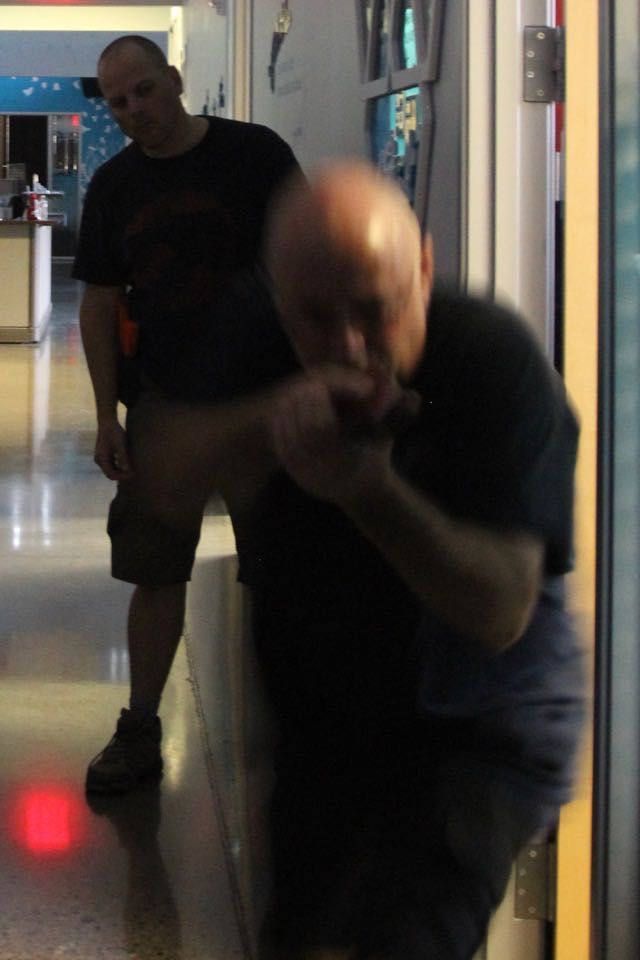
Having gone about an hour past the scheduled end of class, Roger and Ninpo called it for the day. A few folks had to head straight home, but most of us headed over to a local restaurant for a nice dinner and some great fellowship with like-minded folks. Having been a while since I’d seen a lot of these people, it was a great opportunity to catch up with them.
Sunday
We convened again on Sunday morning. After disarming and switching over to our training guns, Roger and Ninpo asked for any questions about the material we’d covered the day before.
One of the questions was about flashlights, and Ninpo talked about his preference for very bright, high lumen tactical lights (especially rifle mounted lights). High lumen, in this case, being a minimum of 500 lumens, with 1000 or more being better. There are people out there who say this is too bright, but Ninpo thinks that used properly they’re very effective. This lead to the obvious follow-up, what’s the proper technique with a light that bright? So we all crowded into the restroom for a demonstration.
Ninpo showed how he would use a light to illuminate that space. Rather than hosing the area he’s interested in down with direct illumination, he relied on lots of indirect illumination, bouncing light off the floor, ceiling, walls, and (since this was a restroom) mirrors. This not only made good use of all those lumens, the shadows this creates can allow you to see around corners to a certain degree as well as helping conceal your position.
The restroom also had a small closet full of cleaning supplies which Ninpo took advantage of to show how he’d clear that sort of space. This lead to some discussion of the ready position he used to retract the rifle so he could reach the doorknob. He angled the muzzle up with the stock buried quite deeply underneath his armpit. As with the short stock position we discussed on Saturday, Ninpo mentioned this is another ready position he does a lot of practice shooting from.
Since the restrooms had self-closing doors, we moved on to practicing with those. They’re a real pain in the ass, but the principles are similar to any other door. Because you can’t open them and have them stay open, you have to fling them open then scan as much as you can as they swing shut. In this case, you’re not just looking for an adversary, you’re also trying to get the lay of the land of the room on the other side, so you can have a plan when you go through. As with opening a closed door, you wait (making maximum use of the advantage of initiating the action). After five or ten minutes you fling the door open and bust through, dealing with whatever you find on the other side.
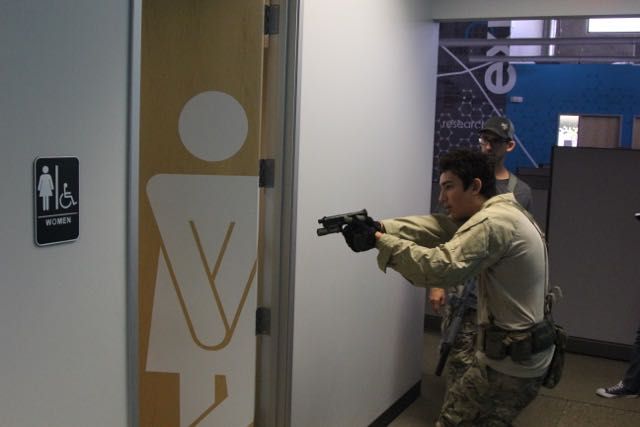
We broke up into the two groups and did some practice with the self-closing doors. Self-closers are definitely a real pain to deal with. Along with issues with the doors themselves, when coming back out, we continued to see students failing to slow down and relax after they cleared the door.
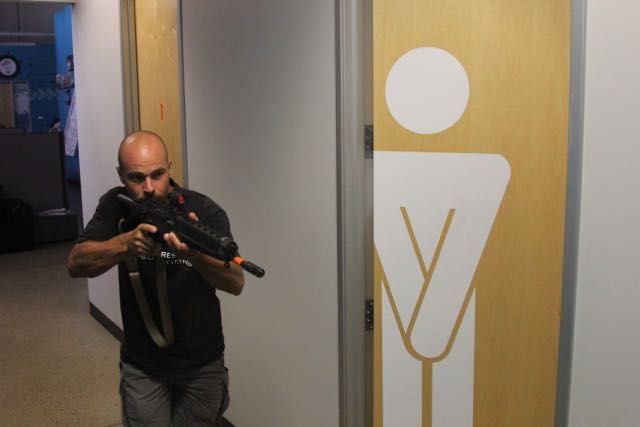
When we were practicing room exits on Saturday, Roger noted that we generally weren’t including the quick peek in the opposite direction that Ninpo included when he came out of a room. He asked Ninpo to demonstrate this. Ninpo showed just a quick glance over his shoulder as he cleared the doorframe; not really enough to assess a potential threat, but enough to see if there’s something there that needs a more thorough assessment. If there is someone there, he’ll short circuit his check of the original direction, do a quick 180 and address the potential target he spotted to the rear.
All of our practice to this point had involved one obstacle at a time. We moved on to some practice clearing multiple rooms along a hallway in a row. If the rooms are widely separated, this isn’t much different from clearing a single room. However, if the doors are close together, the combination makes it a more complex problem. It forces you to divide your attention between the room you’re working and keeping an eye on the next room and limits how much of the first room you can get a look at during your angular search before you have to commit.
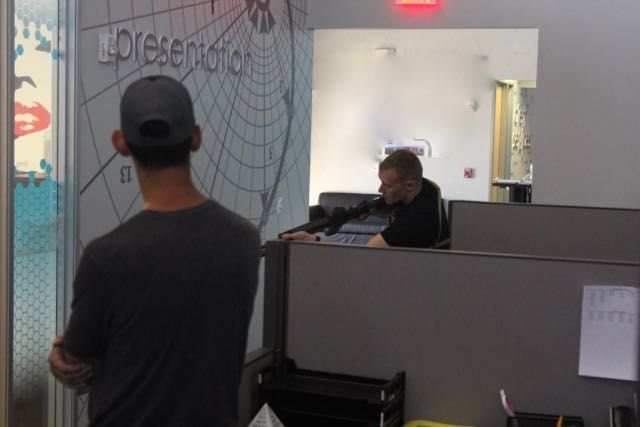
Ninpo did some demos, and we spent some time searching multiple rooms, starting with all the doors open, the moving on to having all of the doors closed. With multiple rooms, having the doors closed can actually simplify things because it allows you to isolate one problem at a time. While we were doing the multiple room drills, we also practiced using the quick peek when coming out.

Even more than clearing individual rooms, these drills highlighted people’s tendencies to get faster and faster as they searched. They started out at a nice slow, relaxed pace for the first room, then went a bit faster coming out of that room, even faster in the second room, and faster still coming out of the second room and heading to the third. “Slow down, relax.”
Since the rooms we were clearing were all offices, one thing that came up was how to search under a desk effectively. Ninpo noted that desk surface generally isn’t going to stop a bullet, so you don’t necessarily need to get the rifle clear of the desk. If you see (and positively identify) an adversary under a desk who needs to be shot, you can start lighting him up through the desk itself.
We took a break for lunch. While we were eating, there was some great discussion about related topics, like what you can do to your house to make it less likely to be selected by criminals and easier for you to fight in. Ninpo also had some good recommendations on books about the criminal mindset and psychology.
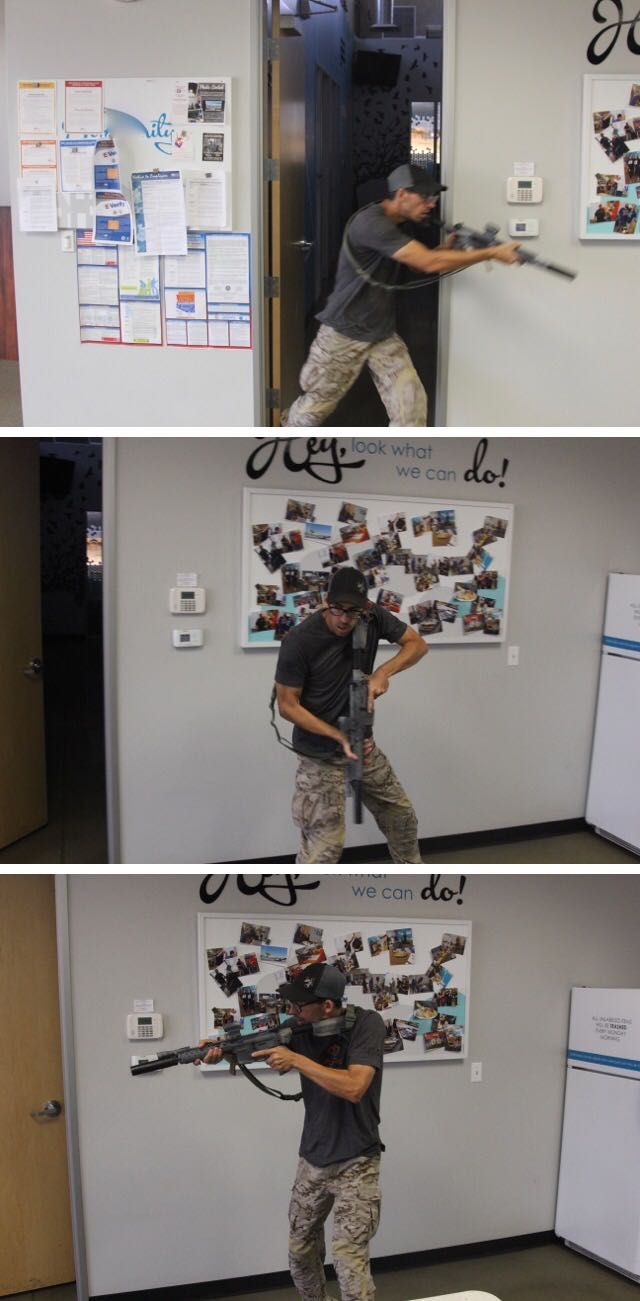
Thus far all of the rooms we had been working were corner-fed (the door was near one corner of the room), primarily because in this building center-fed rooms were in much shorter supply. We did have one, however, and after lunch, Ninpo did some demonstrations of clearing a center-fed room. We then had the opportunity to try it for ourselves.
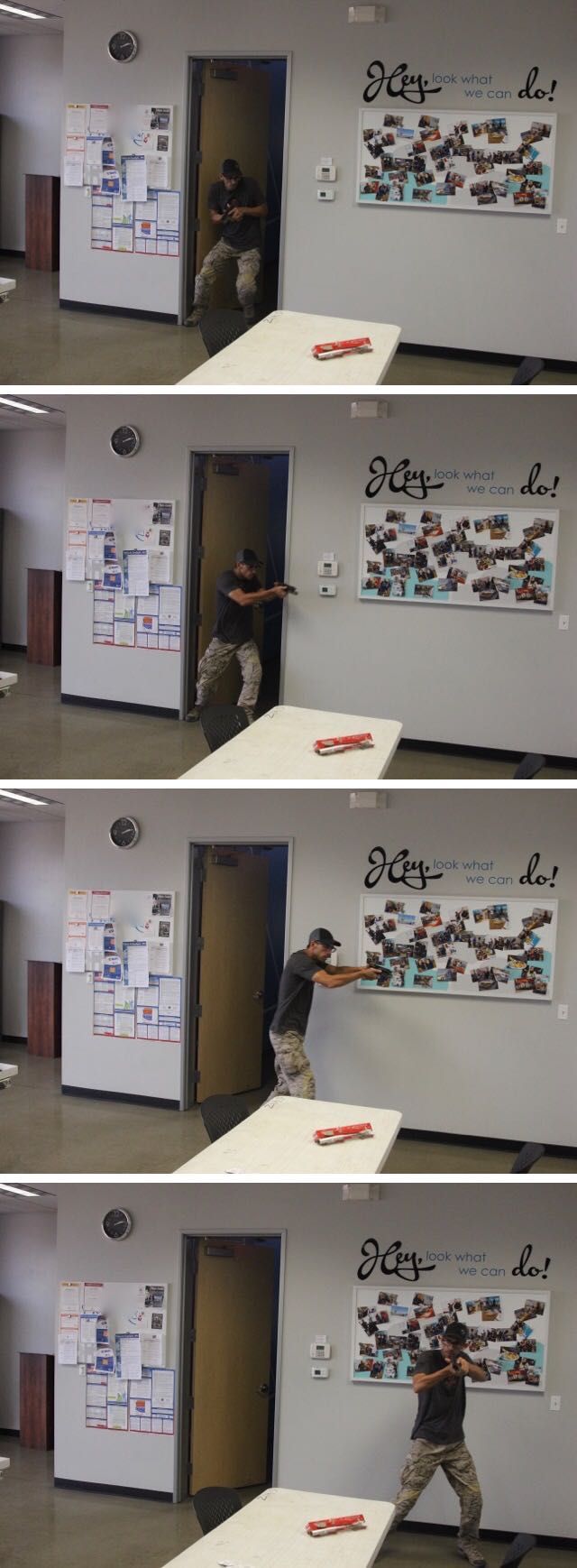
Roger and Ninpo talked a bit about 2-man teams. Having more than one person makes many CQB problems much, much easier because you can address two danger areas simultaneously. This can be as simple as having a partner to keep an eye out to the rear as you move down a hallway up to being able to address both sides of a T-intersection or center-fed room simultaneously. Even when there’s only one threat, having multiple team members means that adversary has to deal with multiple problems while you and your teammate can fill him in twice as fast.
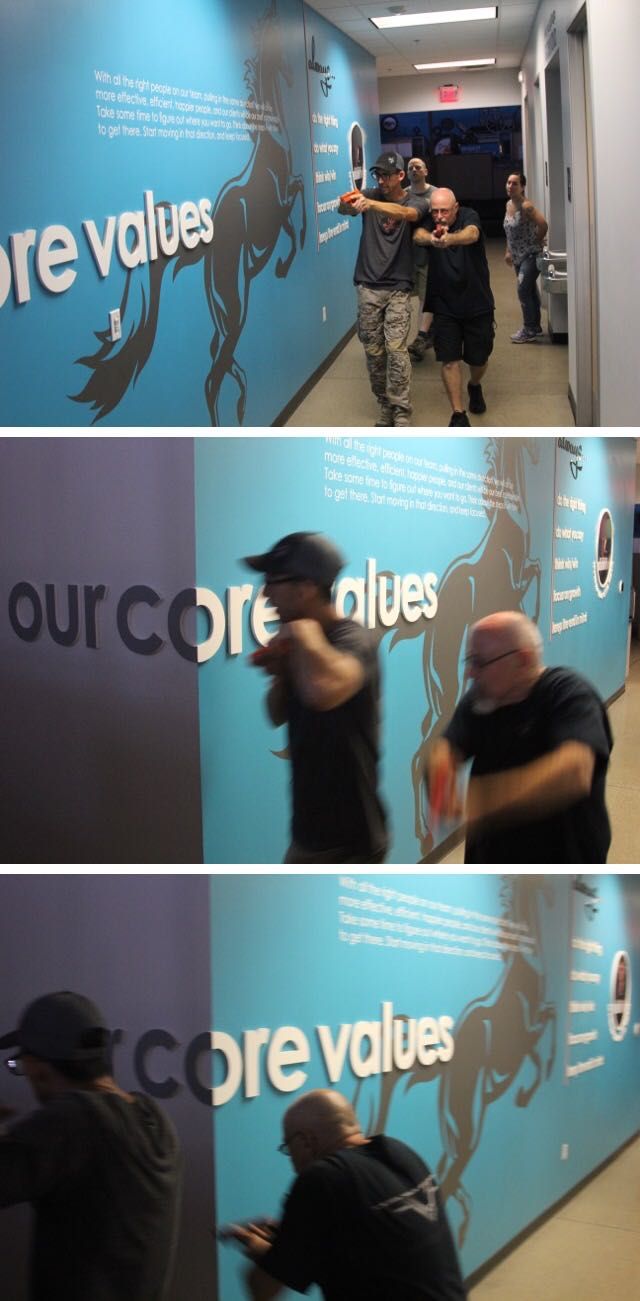
While I’ve done some 2-man CQB before, Ninpo demonstrated a pair of techniques that were new to me: the skid and the slide. Both are ways for two guys to take a corner or door simultaneously, rather than sequentially. In the skid, the #1 man takes the inside of the corner and slows down for a moment to let the #2 guy step around him and take the outside. In the slide, the #1 man steps to the outside, opening up a space for the #2 man on the inside.
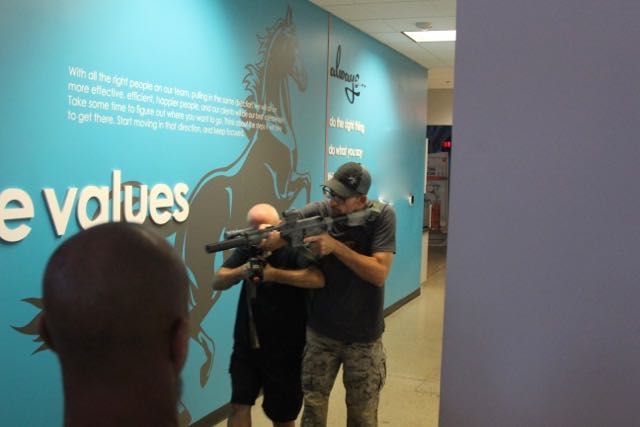
Ninpo and Roger also demonstrated how to move down a hallway and clear a T-intersection with a 2-man team. We had a nice broad hallway to demo with so rather than stacking up they moved down it side by side, allowing them to get two guns on the threat. They also showed how one team member can serve as the tailgunner if you have a potential threat area to the rear.
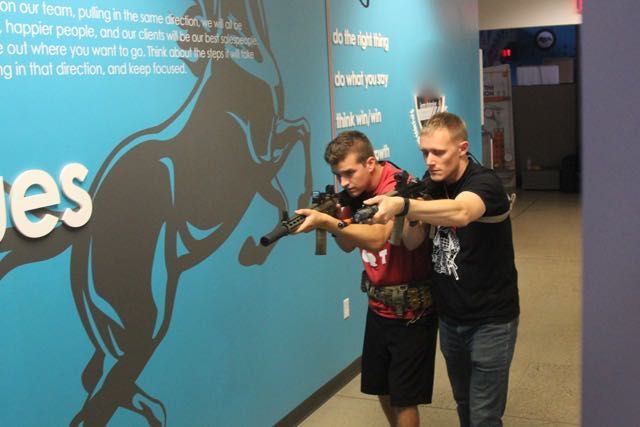
We had a chance to pair up and practice some of the 2-man team CQB. One of the things that came up repeatedly was a gap developing between teammates. Ninpo emphasized that in this context was continuous physical contact between teammates was critical. This could be a hand on the shoulder if the guy in front of you in the stack, moving shoulder to shoulder if you’re side by side, etc. It’s crucial because the sudden lack of that contact is a signal to the #1 man that he’s either going too fast or the #2 guy had to stop and address a potential threat.
Another student and I were practicing using the skid and slide techniques to get around an L-shaped corner. We had run the skid several times (where the #1 man cuts inside while the #2 goes wide) with me as the #2 man. When we swapped roles, I decided that we’d try out the slide (#1 man goes wide leaving a space for the #2 man on the inside). Ninpo had said that the #2 man should be able to pick up which technique the #1 guy is doing and accommodate, so I didn’t bother to discuss this change beforehand. In this case, the guy running the drill with me did not pick it up, and we both tried to go to the outside, which basically ended up with me body checking him into the wall.
Ninpo thought this was about the most hilarious thing he’d ever seen. He also decided that maybe we weren’t quite at the level where the #2 guy could just roll with it, so for the rest of the drill our SOP would be that if the #1 man went muzzle up, he was doing the slide and if he went muzzle down, it would be a skid.

After everyone had a chance to do a few reps (which did not involve anyone getting slammed into the wall), we moved on to doing 2-man room entries. This is where the slide entry really comes into its own. It basically allows you to get two people into the room almost simultaneously even through a doorway too narrow for them to enter side by side. It has some real advantages over the traditional sequential entry.
Once you’re through the door, one guy goes one direction while the second guy goes the other way. The ability to cover two separate sectors like this makes room entries far easier with a two-man team than solo. Ninpo noted that experiences in Iraq have lead to a shift in how deeply to move into the room. Insurgents were sucking guys in deep then blowing up the room (or the entire building). The response has been not to penetrate as deeply into the room to make it easier to pull back if necessary. This doesn’t mean fighting from the door, but as a general rule, it means not getting more than halfway down the left and right side walls of the room, even with a 4-man team.
Everyone had a chance to practice a few 2-man room entries before Roger and Ninpo called an end to the class. Roger handed out the certificates, and we all packed up and reluctantly went our separate ways.
I headed over to a new hotel nearer the airport for Sunday night. On the way, I stopped at a nice local Italian restaurant for dinner. Monday morning I returned my rental car and headed to the airport for my flight back home.
Conclusions
This was a fantastic class. Ninpo is a veritable fountain of information about CQB, and I picked up more stuff from this class than I have in a long time. Roger let Ninpo take the starring role for this course, but I don’t want to sell him short either. He’s the one who really provided the overall structure to the class, and his excellent coaching skills really came to the fore when we broke up into groups to practice these skills.
While I’ve taken (and even taught) CQB classes before, as I’ve broadened my horizons and trained with a more diverse group of instructors my thinking on some of this stuff has evolved. This class has definitely contributed to that.
Probably the most significant change that this course has me contemplating is when (and why) to switch hands/shoulders during CQB. I’d been moving in the direction of not swapping sides as often after some training with other instructors. This course has accelerated that process; after seeing how Ninpo runs this stuff he has me converted most of the way over to his way of doing things.
The other big lesson from this class was the need to slow down and relax. This is something that came up again and again during class. Going too fast will get you killed. Trying to stay tensed up in a hardcore shooting position the whole way through a search and clear is going to wear you out very quickly. The ability to shift gears, slow down, and relax is as critical a skill for CQB as taking a corner or making a room entry.
The corollary to this, since you’re not going to be in a shooting position the entire time, is the need to practice going to a shooting position from ready positions: contact ready, compressed high ready, Sul, and short stock ready for a rifle; contact ready, compressed contact ready, high ready, and Sul for a pistol. Start relaxed in these positions and practice driving quickly into a proper shooting stance.
In addition to these larger points, this class also provided a ton of small refinements to my CQB technique. The aforementioned short stock ready position, the way Ninpo uses doorjamb takeoffs getting into (and out of) rooms, the sideslip room entry, the quick peek on exiting a room. Even tiny things like keeping the toe pointed in towards the apex of the corner so it’s less likely to be the first thing your adversary sees.
One that I did not get a chance to put into practice since I didn’t attend the live fire day was the torquing the hands inward as part of the handgun shooting grip. I need to make a trip to the range to try that out.
We also had a great group of students in this class. Many of them were folks I’d trained with before, but some were new to me. All of them asked good questions, did well practicing the skills we were learning, and served as good training partners in the 2-man team drills. They’re all great folks, and the class was a nice opportunity for fellowship with like-minded individuals.

